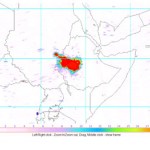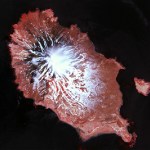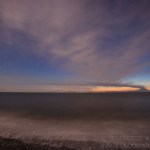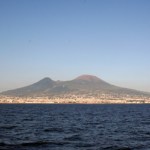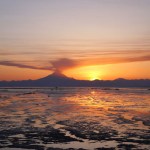volcano monitoring
Three days ago, I received an email from Eruptions reader Gijs de Reijke who was curious about something he noticed in the daily OMI SO2 images:
OMI sulfur dioxide map over Ethiopia for June 30, 2009.
Now, I wasn't quite sure what to make of it other than the fact that there was an awful lot of sulfur dioxide in the vicinity of Addis Ababa, which seemed odd. If we look at a map of the active volcanoes in Ethiopia (below), a majority of the ones we might suspect if the SO2 was volcano are to the north (Erte Ale, Dallafilla), but this patch is smack-dab in the middle of the country, looking…
A wrap up of the week's volcanism, brought to you by Sally Kuhn Sennert and the USGS/SI Global Volcanism Program.
Highlights, not including Sarychev Peak, Redoubt and Shiveluch (busy week in the north Pacific), include:
A small ash cloud was spotted at Bagana in Papua New Guinea.
The Tavurvur cone at Rabaul (PNG) continues to glow at night and produce small ash/steam plumes.
The Santiaguito dome at Santa Maria in Guatemala produced 8,000-10,000 foot / ~2.9-3.3 km ash plumes, along with a lahar that carried blocks over 1.5 m downstream from the volcano.
A 25,000 foot / 7.6 km ash plume was…
The NASA Earth Observatory has posted some excellent images of Matua Island in the Kurils that show the before and after of the Sarychev Peak eruption of June 2009. There are some impressive changes ... so lets see if you can spot them! Post your comments on whats changed and why and I'll chime in periodically with what I've noticed.
BEFORE: Matua Island and Sarychev Peak in May 2007 (big version)
AFTER: Matua Island and Sarychev Peak in late June 2009 (big version)
Redoubt steaming in early 2009. Image courtesy of Calvin Hall.
It has been a while since we spoke of Redoubt, but now it seems the reason why might be that the eruption is ending. AVO lowered the Alert Level at Redoubt to Yellow from Orange, indicating that they believe the volcano is less likely to have a large eruption. This doesn't mean that it is out of the question, but rather that signs seem to be pointing to the idea that the eruption is waning.
AVO sums the change:
Seismic, satellite, gas, and deformation observations over the past few weeks indicate that growth of the lava dome at…
Shiveluch volano in Russia.
Just like last summer seemed like a busy time for the Aleutians (Cleveland, Okmok and Kasatochi), this summer could be dubbed the "summer of Kamchatka-Kurils" (alright, it isn't that catchy, sorry). The biggest news was/is, of course, the sizeable eruption from Sarychev Peak in the Kuril Islands, but not to be outdone, Shiveluch on the Kamchatka Peninsula has starting playing catchup.
KVERT is reporting that Shiveluch produced a 7 km / 23,000 foot ash column on Monday, with increased seismicity to go along with the explosions. These explosions are generating the…
The Q&A post will be coming over the weekend (there's still time to send me a question!)
Icy cold volcanoes (well, geysers) on Enceladus, a moon of Saturn.
In the meantime, here are a few quick hits:
Mt. Cleveland in the Aleutians had a small eruption. The plume was only ~15,000 feet / ~3 km. Cleveland is one of the more active volcanoes in the Aleutians, so this eruption is not out of the norm.
Landslides and rockfalls at Arenal (in spanish) in Costa Rica continue to prompt evacuations of tourists near the volcano. It is interesting to note that officials don't seem worried about hotel…
Busy busy analysing on the multicollector ICP-MS today (but not busy enough to miss this).
Here's your weekly volcano news roundup from the USGS/Smithsonian GVP.
Highlights (not including Sarychev Peak) include:
Continued dome growth and degassing at Bezymianny in Russia. Starting next year, there will be live webcams for three of the major volcanoes (Bezymianny, Kliuchevskoi, and Shiveluch) on the Kamchatka peninsula! Now, that is exciting news.
The glowing coming from the vent in the Halema'uma'u Crater at Kilauea in Hawai'i is still prominent. The lava levels in the crater have been…
A few quick news bits ... and thanks for the questions so far. Keep 'em coming!
Tungurahua, Ecuador erupting in 2006.
Ash fall from Tungurahua (in spanish) in Ecuador is affecting the farm towns around the volcano. Farmers in Manzano, a village nearby, fear the ash is significant enough to damage their crops. The volcano itself is throwing incandescent bombs near the vent along with producing copious ash.
There is a nice piece in the News Tribune about how Alaska Airlines handled the eruption of Mt. Redoubt near Anchorage this March. It is nice to get some insight into how airlines deal…
Some volcano news before the weekend:
The Barujari vent at Mt. Rinjani erupting in May 2009.
Barujari, the small basaltic volcano located in the crater at Mt. Rinjani, is "spewing 200-meter-high lava", at least according to recent reports. It is unclear if the eruption is, in fact, a fountain or merely strombolian activity throwing incandescent blocks that high (see above). My guess is that it is the latter, as that is much more typical for Barujari. Another report mentions a 600 meter "river of lava" (in spanish) that ends at Segara Anak lake. The volcano has been erupting all spring with…
Sarychev Peak erupting on June 12th. Image taken on the ISS, courtesy of the NASA EO.
The eruption as Sarychev Peak seems to be waning a bit, at least according to some of the latest images from the NASA Earth Observatory's collection of MODIS shots. The ash plume is less prominent - and strikingly more grey than before, possibly if it contains a higher proportion of water vapor than the earlier plumes. However, it isn't these brand new shots that captured my attention but rather one of the possibly most stunning volcano images I've seen in years (above). This captures Sarychev Peak as a…
Your weekly dose of volcano news brought you by the Smithsonian Institute GVP and the USGS.
This week's highlights (not counting Sarychev Peak and Turrialba) include:
13,000 foot / 4 km ash plumes from Rinjani in Indonesia. This is part of the continuing eruption there.
The alert level was lowered at Galeras, Colombia to "Orange" after intense eruptions last week.
The current lava dome at Redoubt is 1 km long, 460 m wide, and 200 m high according to the latest images from the Alaskan volcano.
18,000-23,000 foot / 4.8-7.7 km ash plumes from Shiveluch in Kamchatka, along with thermal anomalies…
Flight path for Continental Flight 009 from Newark to Tokyo, diverted back to Newark due to the threat of ash from Sarychev Peak. Image courtesy of Flight Aware.
The eruption at Sarychev Peak is continuing to disrupt all sorts of flights that head towards Asia. There are lots of unhappy travelers who have had to "enjoy" a 12 hour flight that took them from Newark, NJ to ... Newark, NJ (see yesterday's Continental Flight 009 above). There have been a multitude of flights affected by the ash, many reported here on Eruptions by travelers or relatives (keep them coming!) It will be interesting…
Arenal in Costa Rica, erupting in July 2007. Image courtesy of Arenal.net.
Arenal in Costa Rica is one of the most active volcanoes in Central America. It is almost one of the most picturesque (see above) and, dare I say, touristy, volcanoes in the world. However, even volcanoes that seem "benign" like Arenal require special precautions.
Yesterday Arenal has two small eruptions that were accompanied by unusual tremors, (in spanish) according to Javier Pacheco of the Volcanological and Seismological Observatory of Costa Rica (OVSICORI). The tremor started at 7 AM and continued until 4:30 PM,…
Matua Islands (also known as Matsuwa Island), home of Sarychev Peak.
The eruption of Sarychev Peak in the Kuril Islands has been wreaking havoc on flights to and from Asia for the past few days (as many Eruptions readers can attest). You can see the latest VAAC (Volcano Ash Advisory Center) statement here that shows ash to at least FL380 (38,000 feet / 11 km). Predicted ash movement (see below) for the next couple of days has ash moving to the southeast of the volcano and the U.S. Air Force has detected ash as far as 1500 miles / 2400 km southeast and 575 miles / 900 km northwest of the…
Sarychev Peak in the Kuril Islands in 2007, the source of the large ash column currently disrupting transpacific air traffic.
It seems that the eruption at Sarychev Peak in the Kuril Islands of Russia might be a lot bigger than it first seemed. I've gotten a couple reports of flights to Tokyo from North America being diverted or delayed due to the ash threat, including All Nippon Air Flight 1 (Washington DC to Tokyo) and Continental Flight 7 (Houston to Tokyo, diverted to Anchorage). The NASA Earth Observatory has some great new images of the eruption taken today from the MODIS on the Aqua…
I won't try to recap all the news from last week, but I did notice a few articles from this weekend worth noting:
The Big Obsidian Flow at Newberry Volcano. This rhyolite lava flow erupted at ~1,300 years ago.
Geologists in Greece are keeping an eye on a submarine volcano called Columbus. Apparently a number of M4+ earthquakes have been reported, the sea floor has deformed and there have been "hot air eruption" (? ... I am a little skeptical of the last one without more details). The article is a little fuzzy on the details: the volcano is 6.5 meters southeast of Santorini and the Santorini…
Sarychev Peak in Russia erupting on June 14, 2009. Image courtesy of the NASA Earth Observatory.
The transpacific air routes over the Aleutians, the Kamchatka Peninsula and the Kuril Islands are a prime location for the threat of ash to commercial aviation. Many of these volcanoes, especially on the western side of the Pacific Ocean are not closely monitoring and sometimes only remote sensing techniques can keep track of the activity.
Case in point is the current eruption at Sarychev Peak in the Kuril Islands. The volcano is on one of the southern-most Kuril Islands (Ostrov Matua) in Russia…
The latest in my Volcano Profiles Series, we turn to Europe and Vesuvius. You could fill many, many volumes with the works produced on Vesuvius since Roman times. This profile will barely scratch the surface when it comes to the vast geologic and human history surrounding the volcano, but it is a start. If you want to learn more about the archaeology surrounding Vesuvius, try visiting Blogging Pompeii.
VOLCANO PROFILE: MT. VESUVIUS
Mt. Vesuvius in Italy. Image courtesy of Dario Leone.
Location: Italy
Height: 1,281 m / 4,203 ft
Geophysical location: The tectonics in the Mediterranean are…
One brief note before I head out the door ...
Fissures formed in western Saudi Arabia during the earthquake swarm near Harrat Lunayyir during May and June 2009. Image courtesy of Ahmed Al-Hussaini.
The earthquakes in the Harrat Lunayyir region of western Saudi Arabia seem to be like a character out of Monty Python and the Holy Grail: they're just not dead yet. Two more earthquakes, these in the M3 range at 8-9 km depth, hit Thursday morning, further delaying the return of evacuees to the Al-Ais region. This bring the total earthquakes to over 150 since seismicity began a few weeks ago.…
This will likely be my last new post for the next week or so. I'll be off to my home town for a wedding and a reunion. If you're jonesing for up to date volcano info, be sure to visit the Volcanism Blog or the European Volcanological Society news page. Feel free to post any other links you know or breaking volcano news over on the open thread as well! I will be posting a couple pieces over this next week, including the next volcano profile, so stay tuned for those as well. Regular posting of new volcano news should return June 15.
Mt. Redoubt in Alaska steaming in spring 2009. Image courtesy…
